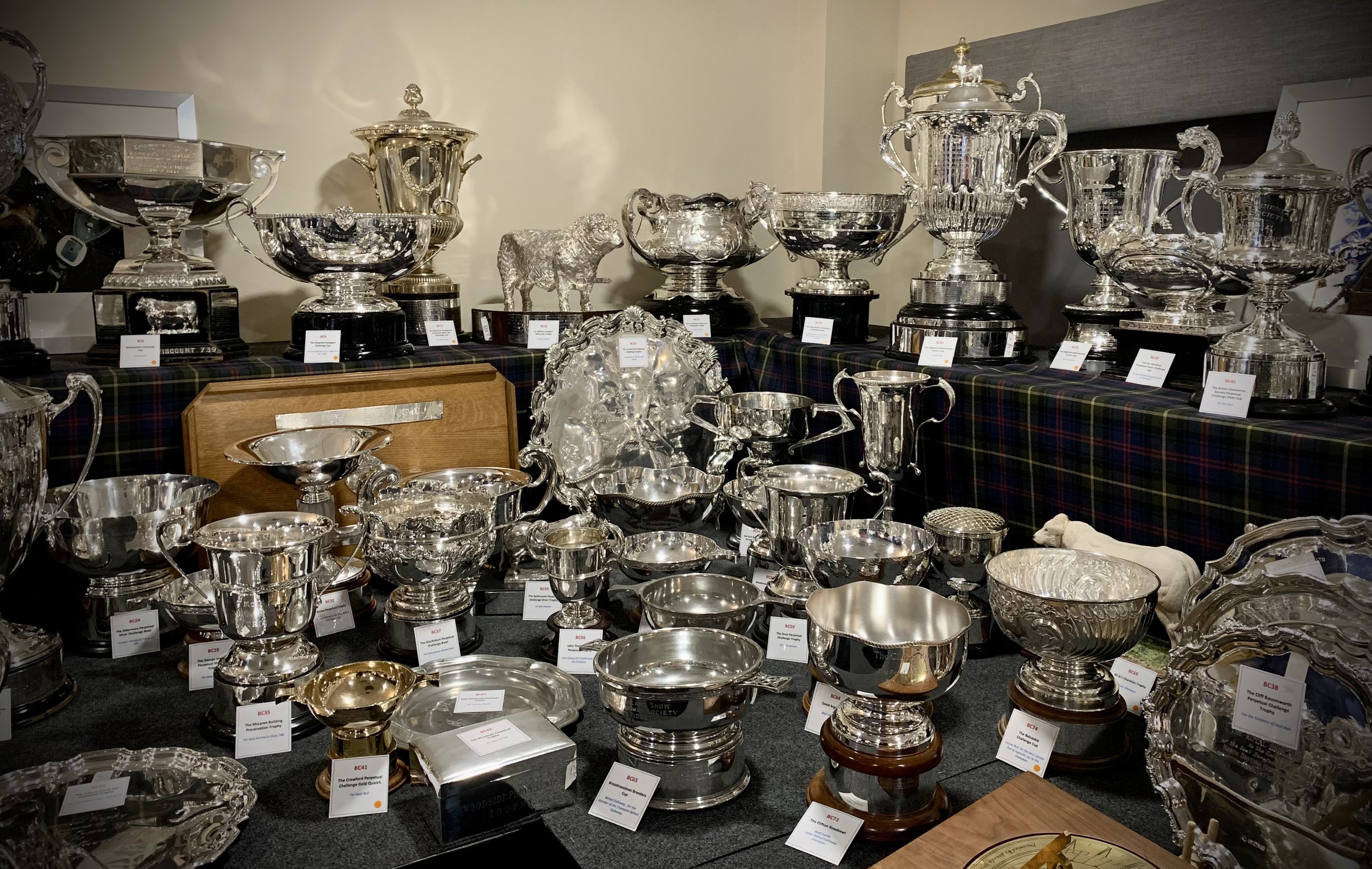Sprawling car park slowly negotiated and car finally parked, the walk over to the Royal Highland Show ground at Ingliston, Edinburgh, never fails to thrill. It’s been a while since I last had the pleasure of visiting but it’s comforting to see, hear - and smell - that not much appears to have changed.
The neighing of outrageously beautiful light horses as they’re led in from the paddock before going into be shown; the quiet dignity of magnificent Clydesdales being brushed and primped; bleating sheep of all breeds, sizes and shapes in pens as far as the eye can see; and then the Cattle Hall. I confess this to be my favourite livestock area of the Show, which this year hosted 6000 animals across all categories. I just manage to catch the newly-awarded Champion British Charolais bull parading round his field for the photographers, and what a mighty beast he is (left). There were 327 trophies awarded this year (detail, bottom photo).
Such a display of Scotland’s rural and agricultural life wouldn’t of course be complete without the showcasing of its produce. I meet with Louise Elder, who runs Scotland’s Larder, the huge food and drink hall, the day before an important Meet the Supplier event where the 95 producers present are to meet with buyers from farm shops to wholesalers. This event is a significant new development which is only in its second year. Louise Elder says they are trying to get farmers, growers and crofters to meet trade and thereby grow their brands.
Louise was a member of the original Scottish Rapeseed Oil group of eight producers from across the country, formed in 2017 and now down to four as individual brands develop their own paths to market.
Scottish Honeyberries is a new group of eight growers of this unusual new fruit from the edible honeysuckle, which originates in Japan. Carina Scott, a honeyberry grower from Berwickshire, explains that the long, blue-black juicy citrus fruits - whose taste hovers between blueberry, grape and plum - have been successfully grown Scotland, from the Highlands to the Borders, since 2017. This is their first Royal Highland Show, and the aim is to spread the word about the honeyberry’s nutritional benefits - apparently they contain four times the antioxidants of blueberries. The group is expanding the 80 acres currently used in order to increase production.
Over at AVA Berries of Arbroath, Angus, they are celebrating their 30 year anniversary of growing strawberries, raspberries and blackberries for sale across the UK, Europe and Asia as well as redcurrants and cherries under its Good Natured Berries brand. The Angus Soft Fruits network of growers supply some 80% of all Scotland’s, and 20% of the whole UK’s, berries.
The Middle East and Asia, including Hong Kong, Japan and South Korea, are emerging markets for AVA Berries.
“South Koreans and Asians will gift our fresh strawberries to friends instead of the usual wine or chocolates,” marketing director Jill Witheyman tells me. “Our strawberries are regarded as very special and they boast that they are Scottish. They are seen as something to be proud of.”
“South Koreans and Asians will gift our fresh strawberries to friends instead of the usual wine or chocolates,” marketing director Jill Witheyman tells me. “Our strawberries are regarded as very special and they boast that they are Scottish. They are seen as something to be proud of.”
Angus Soft Fruits also have a breeding programme and the newest raspberry varieties are called AVA Monet and AVA Dali due, I understand, to their visual appeal as well as their flavour. Sadly I can’t taste them as they are being kept for the MTS event next day.
Sustainability is key for the sector. The growing market for vegetable-based ‘chips’ - as opposed to potato crisps - is in evidence with Shore of Wick’s seaweed products in various flavours (Peking Duck was my immediate fave) and Growers Garden of Fife’s Wonky Broccoli and Cauliflower chips in various flavours (parsnips are next in line). (I happen to know that Scotty Brand have also launched a new line of Beetroot Chips but they aren’t at the Show.) Going with the global culinary trend for Asian flavours, Baxters Food Group are sampling their new Indian Spiced Cauliflower soup alongside jars of Korean-inspired Kimchi.
There weren’t as many artisan cheese producers there as at, say, ScotHot or the Speciality Food Show but Damn Fine from Dumfries-shire are here, and Orkney Creamery say their chilli Cheddar cheese is a best-seller. There are several ice-cream makers including Mackie’s, Lucas, Orkney and Loch Ness.
I imagine that what I perceive as a dearth of new, small, independent artisan Scottish producers at the Show may be due to the cost of hiring a stand and the commercial/manpower viability of taking four or five days out of production.
However, I’m heartened to see that just beyond Scotland’s Larder, the Scottish Dairy Championships, including new Milk and Cream classes, are quietly underway in a neighbouring hall. It is a sight for sore eyes to watch the judges conscientiously sipping their way through over 40 locally produced milks and creams to finally name Jolly Jersey Milk of Strathaven as Champion Milk Exhibit and Park Farm Dairy of East Kilbride the Champion Cream Exhibit. And, out of an astonishing 140 types of ice-creams and sorbets, it is Equi’s of Hamilton who take both Overall Champion Ice-Cream and Overall Dairy Produce Champion for their vanilla ice-cream.
I later learn that (human) visitors to the Royal Highland Show this year numbered 220,000 over the four days, up 2.5% from last year, with ticket sales grossing £3.3m.
Which may explain why, as I leave the ground after a few busy hours, I find myself facing an inexorable tide of incoming visitors, making it - quite literally - difficult for me to leave.





